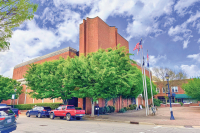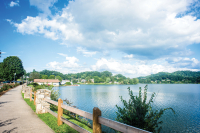Ressurecting the Ghost of Maggie past
Bob Cordier likes a challenge.
So, when the 25-year veteran of the amusement park industry decided he was bored with building houses and was ready to get back into the business, Ghost Town in the Sky seemed a natural fit.
“How many times do you get to open a dead park and bring it back?” said Cordier, Ghost Town’s general manager, whose resume includes time at Water Country USA and Wet ‘n Wild Emerald Pointe. “I was also impressed with Ghost Town’s history, and what it means to this community.”
Cordier also is struck by the possibilities.
He and others in the park’s leadership are discussing expansion even before the Friday, May 25, reopening of the Wild West theme park.
The plan is to stoke the excitement generated by Ghost Town’s rebirth by adding at least one new attraction each year. Their talks have included these possibilities:
Related Items
• A Western-themed hotel.
• Horse-riding trails.
• An indoor-outdoor water park.
• An outdoor skating rink.
• Adding lights and staging night events, such as a “haunted” Ghost Town.
“The potential is huge — we are limited only by how many people I can get up that mountain,” Cordier said.
And, even that might not prove limiting. There’s room for another chairlift, he said, which would add 40 percent more capacity. There’s also road access to the peak of the 4,600-foot mountain that towers above Maggie Valley, though turning two-lane Rich Cove Road — the steepest state-maintained road in North Carolina — into a visitor viaduct could prove challenging.
Nostalgia key to new Ghost Town
Two hundred thousand people are expected to visit Ghost Town this year. Cordier expects that number to increase rapidly, ultimately hitting the park’s 400,000-person capacity limit and matching visitation numbers posted during the halcyon years of the 1960s-built theme park.
To ensure success, Ghost Town has embarked on an aggressive marketing campaign. Advertising — print, radio and television, plus billboards — has been purchased throughout a 200-mile radius. The theme park has partnered with Ingles Markets and is selling season passes through the company’s grocery stores.
Additionally, four salespeople were hired to cold-call 7,200 businesses in a 100-mile radius of the park and talk about the re-opening.
The target audience is parents or grandparents and children, not the older teen looking for high-thrill rides, Cordier said.
Ghost Town lands squarely between those amusement parks geared toward rides and those geared toward entertainment, offering an array of both. And the Wild West theme is expected to play well with parents who enjoyed westerns such as Roy Rogers, Hopalong Cassidy, Gunsmoke and Wagon Train, and are eager to share those experiences with their children.
“As the baby boomers age, there’s nostalgia to go back to when they were kids,” Cordier said. “The more that population grows, the more viable Ghost Town will continue to be.”
One key to pushing the visitation numbers will be attracting groups, said David King, the sales and marketing manager.
“I believe that is what will make our success,” said King, who previously worked for the Asheville Tourists baseball team.
Groups targeted include Boy Scout troops, school children and home-schooled children, via “days” dedicated to each one.
“We’re being very proactive,” King said.
The marketing manager said the most significant challenge facing the theme park is helping people forget the slow decay that took place before it permanently closed in 2003.
“It’s the perception. People remember coming here and the rides not working,” King said.
Multiple breakdowns of the chairlift in 2001 and 2002 left tourists stranded on the mountainside and required rescues with ropes and harnesses, and the state finally revoked Ghost Town’s chairlift permit.
The loss of that permit essentially sealed the fate of Ghost Town, the brainchild of R.B. Coburn, who also developed Frontierland in Cherokee. Russell Pearson of Kansas was Ghost Town’s designer.
‘A huge undertaking’
Work on the theme park started on Sept. 1, 1960, when three bulldozers shaved 45 feet off the top of Buck Mountain, according to a historical pamphlet, “The Story of Western Carolina’s Ghost Town in the Sky,” published by the theme park in the 1960s.
The construction of the incline railway is described as a “spectacular, daredevil feat for the bulldozer operators who carved out the 50-feet wide, 3,364-feet long roadbed ... the 25-ton bulldozer was manipulated like a yo-yo, moving up and down the face of the peak on a 4-inch cable. The other end of the cable was anchored to a winch on another bulldozer on top of the mountain.”
Coburn went to great lengths to create his western town, to offer “all the atmosphere and spirit of the romantic, robust days when men were men and bullets were law,” the historical pamphlet noted.
The chairlift was ordered from Italy. About 200 local workers were hired to build 40 structures, which the historical account noted the effort required 300,000 feet of lumber, 200,000 feet of plywood and about 20,000 pounds of nails. More than 20,000 feet of underground electrical wire was installed.
When the time came to refurbish the park, little had changed from those earliest days. The original electrical wire and fuses had to be replaced with about five miles of modern wire, and crews also labored to restore the rundown replica buildings.
All but three rides were saved, Cordier said.
About 160 entertainers auditioned and 50 were hired, and workers for other parts of the theme park also were brought on board. A total of 250 to 300 people will eventually be hired to work at the theme park, and an estimated 15 to 20 percent of those are former workers for Coburn.
Buying and refitting the park has cost about $17 million, said King, the marketing manager.
“This has been a huge undertaking. It’s a brand new park with 40 years of history,” he said.









